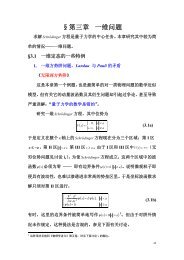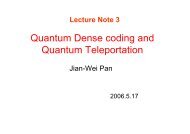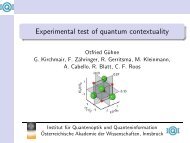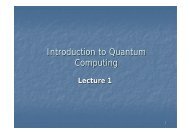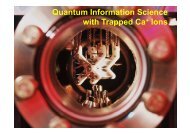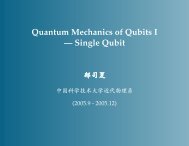Ultrafast optical control of semiconductor spin qubits toward ...
Ultrafast optical control of semiconductor spin qubits toward ...
Ultrafast optical control of semiconductor spin qubits toward ...
You also want an ePaper? Increase the reach of your titles
YUMPU automatically turns print PDFs into web optimized ePapers that Google loves.
<strong>Ultrafast</strong> Optical Control <strong>of</strong><br />
Semiconductor Spin Qubits<br />
David Press, Susan Clark,<br />
Thaddeus Ladd, Kaoru Sanaka,<br />
Charles Santori, David Fattal, Kai Mei Fu,<br />
Yoshihisa Yamamoto<br />
(Stanford University &<br />
National Institute <strong>of</strong> Informatics)<br />
Sven Höfling, Stephan Reitzenstein,<br />
Alfred Forchel<br />
(University <strong>of</strong> Würzburg)<br />
International Conference on<br />
Quantum Foundation and Technology<br />
Shanghai, China, July 18-21, 2009
3rd Asia Pacific Physics Conference (World Scientific, Singapore, 1988) p.779<br />
Quantum mechanical aspects <strong>of</strong><br />
<strong>optical</strong> communication and <strong>optical</strong> computing<br />
Y. Yamamoto, M. Kitagawa and K. Igeta<br />
Basic Research Laboratories, Nippon Telegraph and Telephone Corporation<br />
Musashino-shi, Tokyo 180, Japan<br />
Controlled-NOT Gate for Flying Qubits<br />
using Nonlinear Interferometer<br />
<strong>control</strong><br />
|0 C / |1 C<br />
phase<br />
shift<br />
output 1<br />
output 2<br />
Controlled-Phase Gate for Matter Qubits<br />
using Stimulated Raman Scattering<br />
input 1<br />
|0 1 / |1 1<br />
A Fredkin gate using two three-level atoms<br />
and -pulse coherent state field<br />
input 2<br />
|0 2<br />
A nonlinear single photon interferometer<br />
operates as a Fredkin gate.<br />
2
Outline<br />
• Physical <strong>qubits</strong> Optically <strong>control</strong>led <strong>semiconductor</strong> <strong>spin</strong>s <br />
• Essential elements for fault-tolerant quantum information processing<br />
• Qubit initialization<br />
• Single qubit gate<br />
• Two qubit gate<br />
• Projective measurement and entanglement distribution<br />
• Indistinguishable single photons<br />
• Quantum memory (electron and nuclear <strong>spin</strong>s)<br />
3
Physical Qubits<br />
Cavity QED Systems with Single-Electron<br />
Electron-Doped Quantum Dots <br />
100 nm<br />
“Random”<br />
“Scalable”<br />
A post-microcavity with top and bottom DBRs<br />
and self-assembled InGaAs QDs<br />
D. Press, S. Gotzinger, S. Reitzenstein, C. H<strong>of</strong>mann, A. L<strong>of</strong>fler,<br />
M. Kamp, A. Forchel, and Y. Yamamoto, PRL 98, 117402 (2007).<br />
A simple planar microcavity with<br />
a 2D array <strong>of</strong> position-<strong>control</strong>led QDs<br />
C. Schneider, M. Strauss, T. Sunner,<br />
A. Huggenberger, D. Wiener, S. Reitzenstein, M. Kamp,<br />
S. H<strong>of</strong>ling and A. Forchel APL 92, 183101 (2008)<br />
4
Magnetic Spectrum <strong>of</strong> Charged Exciton in InAs Quantum Dot<br />
Magnetic field in Voigt geometry<br />
= - B g h B ext<br />
M. Bayer et al., Phys. Rev. B 65, 195305 (2002)<br />
Trion X -<br />
Electron <strong>spin</strong>s in singlet<br />
Spin is governed by hole<br />
= B g e B ext<br />
Electron e -<br />
D. Press et al., Nature 456, 218 (2008)<br />
5
Single QD Cavity QED System in Strong Coupling Regime<br />
D. Press et al. Phys. Rev. Lett. . 98, 117402 (2007)<br />
QD lifetime in free space 620ps<br />
QD lifetime in resonant cavity 11.3ps<br />
Purcell factor<br />
Device fabricated at<br />
Wurzburg<br />
Quantum efficiency<br />
under resonant pumping<br />
Direct pro<strong>of</strong> <strong>of</strong> a single QD<br />
cavity QED system<br />
(Also see K. Hennessy et al., Nature 445, 896<br />
(2007)<br />
6
Outline<br />
• Physical <strong>qubits</strong> Optically <strong>control</strong>led <strong>semiconductor</strong> <strong>spin</strong>s <br />
• Essential elements for fault-tolerant quantum information processing<br />
• Qubit initialization<br />
• Single qubit gate<br />
• Two qubit gate<br />
• Projective measurement and entanglement distribution<br />
• Indistinguishable single photons<br />
• Quantum memory (electron and nuclear <strong>spin</strong>s)<br />
7
Motivation Why Optically Controlled QDs <br />
Fault-tolerant and scalable quantum information processing systems<br />
based on <strong>semiconductor</strong> cavity QED systems<br />
Nested-purification-based quantum repeaters<br />
Concept: H.J. Briegel, W. Dür, J.I. Cirac and P. Zoller, PRL 81, 5932 (1998)<br />
Fault-tolerant Implementation: T.D. Ladd, P. van Loock, K. Nemoto, W.J. Munro<br />
and Y. Yamamoto, NJP 8, 184 (2006)<br />
One-way quantum computers with topological cluster states<br />
Concept: R. Raussendorf and J. Harrington, PRL 98, 190504 (2007)<br />
Fault-tolerant Implementation: R. Van Meter, T.D. Ladd, A.G. Fowler<br />
and Y. Yamamoto, quant-ph/0906271 (2009)<br />
Unique features <strong>of</strong> QDs as “artificial atoms”<br />
i ) Large oscillator strength: f exciton 100 f atom<br />
<strong>Ultrafast</strong> <strong>optical</strong> <strong>control</strong> <strong>of</strong> electron <strong>spin</strong>s with small <strong>optical</strong> power<br />
ii ) Permanent placement <strong>of</strong> QDs in monolithic microcavities<br />
Scalable multi-qubit operation (two-qubit gate, entanglement distribution)<br />
iii) Excitonic transition wavelength tailored to =1.3/1.5 m<br />
Natural interface to long-distance/broad-band <strong>optical</strong> communication<br />
networks<br />
8
Outline<br />
• Physical <strong>qubits</strong> Optically <strong>control</strong>led <strong>semiconductor</strong> <strong>spin</strong>s <br />
• Essential elements for fault-tolerant quantum information processing<br />
• Qubit initialization<br />
• Single qubit gate<br />
• Two qubit gate<br />
• Projective measurement and entanglement distribution<br />
• Indistinguishable single photons<br />
• Quantum memory (electron and nuclear <strong>spin</strong>s)<br />
9
Spin Initialization and Measurement<br />
D. Press et al., Nature 456, 218 (2008)<br />
Optical pumping + Rotation pulse <strong>of</strong> Θ = π<br />
pump laser<br />
Population in<br />
Single Photon<br />
Detection<br />
T = 1.5 K, B ext<br />
= 7 T<br />
Initialization fidelity:<br />
F 0<br />
= 92±7%<br />
Time for initialization:<br />
10 -3 sec (thermal equilibrium scheme) 10 -9 sec (<strong>optical</strong> pumping)<br />
10
Outline<br />
• Physical <strong>qubits</strong> Optically <strong>control</strong>led <strong>semiconductor</strong> <strong>spin</strong>s <br />
• Essential elements for fault-tolerant quantum information processing<br />
• Qubit initialization<br />
• Single qubit gate<br />
• Two qubit gate<br />
• Projective measurement and entanglement distribution<br />
• Indistinguishable single photons<br />
• Quantum memory (electron and nuclear <strong>spin</strong>s)<br />
11
Spin Rotation with Single Optical Pulses<br />
• A single broadband <strong>optical</strong> pulse can implement<br />
an arbitrary one-bit gate with fidelity <strong>of</strong> 0.999.<br />
If<br />
an effective Rabi frequency<br />
Numerical simulation<br />
based on the three-level<br />
master equation<br />
100fs /2 - pulse<br />
rotation angle is proportional to<br />
pulse energy<br />
• A system clock is provided by the pulse arrival time<br />
from the mode-locked laser.<br />
100fs -pulse<br />
Arbitrary single qubit gates SU(2) can be implemented in a half<br />
period <strong>of</strong> Larmor oscillation.<br />
Theory: S. Clark et al., Phys. Rev. Lett. 99, 040501 (2007)<br />
Experiment with an ensemble <strong>of</strong> donor <strong>spin</strong>s : K.M. Fu et al., Nature Physics 4, 780 (2008)<br />
12
Single QD Experiment: Coherent Rabi Oscillations<br />
Circularly-polarized 4 ps Rotation Pulse<br />
δ e = 26 GHz<br />
BW = 110 GHz<br />
Δ = 270 GHz<br />
Population in<br />
D. Press et al.,<br />
Nature 456, 218 (2008)<br />
(cf. J. Berezovsky et al.,<br />
Science 320, 349 (2008))<br />
13
Two-Pulse Experiment: Ramsey Interference<br />
π/2-pulse fidelity:F π/2 ~ 94% π-pulse fidelity:Fπ ~ 91%<br />
Total time for arbitrary single qubit gate 19 ps (one-half <strong>of</strong> Larmor period)<br />
D. Press et al., Nature 456, 218 (2008)<br />
14
Outline<br />
• Physical <strong>qubits</strong> Optically <strong>control</strong>led <strong>semiconductor</strong> <strong>spin</strong>s <br />
• Essential elements for fault-tolerant quantum information processing<br />
• Qubit initialization<br />
• Single qubit gate<br />
• Two qubit gate<br />
• Projective measurement and entanglement distribution<br />
• Indistinguishable single photons<br />
• Quantum memory (electron and nuclear <strong>spin</strong>s)<br />
15
Basic Concept <strong>of</strong> Qubus<br />
– Non-Local, Measurement-Free and Deterministic Two Qubit Gate –<br />
T. Spiller et al, New J. Phys. 8, 30 (2006)<br />
cavity<br />
input<br />
qubit<br />
output<br />
Time<br />
displacement<br />
(beamsplitter)<br />
<strong>control</strong>led phase shift<br />
(reflection from cavity)<br />
• After the entire sequence, the probe is disentangled from the two <strong>qubits</strong>.<br />
No measurement and post-selection required.<br />
• An overall phase develops proportional to area (topological phase),<br />
A desired phase shift <strong>of</strong> achieved with<br />
16
Dissipative, Measurement-Free and Deterministic<br />
Two Qubit Gate<br />
Driving<br />
Driving field<br />
field<br />
D<br />
pulse<br />
• Cavity resonance depends on qubit state<br />
• Cavity field amplitude from detuned pulse<br />
depends on resonance position<br />
Amplitude “path” <strong>of</strong> cavity<br />
internal field depends on<br />
qubit states<br />
qubit<br />
Qubit<br />
qubit<br />
Qubit<br />
3<br />
2<br />
Qubit-dependent phase space path<br />
<strong>of</strong> cavity field<br />
1<br />
cavity<br />
field<br />
0<br />
Area difference <br />
-1<br />
enough phase for CZ gate<br />
Instantaneous phase difference<br />
-2<br />
smaller than vacuum fluctuation<br />
-1 0 1 2 3 4 5 6 quantum 7 8 erasure 9 10<br />
AC-stark shift depends on cavity field amplitude<br />
Qubits therefore alter each other’s phase<br />
CZ gate for universal logic or cluster state creation<br />
Master equation simulations indicate >99% fidelity with Q=10 5<br />
17
Outline<br />
• Physical <strong>qubits</strong> Optically <strong>control</strong>led <strong>semiconductor</strong> <strong>spin</strong>s <br />
• Essential elements for fault-tolerant quantum information processing<br />
• Qubit initialization<br />
• Single qubit gate<br />
• Two qubit gate<br />
• Projective measurement and entanglement distribution<br />
• Indistinguishable single photons<br />
• Quantum memory (electron and nuclear <strong>spin</strong>s)<br />
18
Differential Phase Shift Projective Measurement and<br />
Entanglement Distribution with Coherent State Pulses<br />
P. van Loock et al, Phys. Rev. Lett. . 96, 240501 (2006)<br />
detuning<br />
cavity<br />
probe<br />
1. Initial states <strong>of</strong> two <strong>qubits</strong><br />
2. Dispersive light-matter interaction<br />
4. Homodyne measurement<br />
(~0.01 : small phase shift in weak coupling cavity QED)<br />
3. Same interaction with qubit 2, followed by dc phase shift -<br />
post-selection<br />
Automatic phase stabilization in fiber transmission line<br />
High probability <strong>of</strong> success at a cost <strong>of</strong> low fidelity (cf. single photon detection schemes)<br />
19
Entanglement Distribution based on Indistinguishable<br />
Single Photon generation and Coincidence Detection<br />
1<br />
2 1 2<br />
D1 D2 D3 D4<br />
click at D1/D2 or D3/D4<br />
click at D2/D4 or D2/D3<br />
Theory:<br />
C. Simon et al., Phys. Rev. Lett. 91, 110405 (2003)<br />
Experiment with trapped ions:<br />
D.L. Moehring et al., Nature 449, 68 (2007)<br />
S. Olmschenk et al., Science 323, 486 (2009)<br />
20
Outline<br />
• Physical <strong>qubits</strong> Optically <strong>control</strong>led <strong>semiconductor</strong> <strong>spin</strong>s <br />
• Essential elements for fault-tolerant quantum information processing<br />
• Qubit initialization<br />
• Single qubit gate<br />
• Two qubit gate<br />
• Projective measurement and entanglement distribution<br />
• Indistinguishable single photons<br />
• Quantum memory (electron and nuclear <strong>spin</strong>s)<br />
21
Generation <strong>of</strong> Indistinguishable Single Photons<br />
from a Single QD in a Post-Microcavity<br />
C. Santori et al., Nature 419, 594 (2002)<br />
Hong-Ou-Mandel dip<br />
22
Indistinguishable Single Photons<br />
from Two Independent 19 F:ZnSe Sources<br />
K. Sanaka et al., to appear in Phys. Rev. Lett.<br />
28nm<br />
1nm<br />
28nm<br />
15nm<br />
100nm<br />
ZnMgSe<br />
ZnMgSe<br />
ZnSe<br />
GaAs<br />
F:ZnSe QW<br />
Coincidence count rates as a function <strong>of</strong> delay time<br />
(Hong-Ou-Mandel dip)<br />
a<br />
Coincidence<br />
probability<br />
b<br />
0.68 0.96<br />
Coincidence<br />
probability<br />
ZnMgSe/ZnSe<br />
nanostructure B<br />
GaAs<br />
substrate<br />
42m<br />
ZnMgSe/ZnSe<br />
nanostructure A<br />
Pulse laser<br />
spot region<br />
c<br />
Coincidence probability<br />
Delay (ns)<br />
Delay (ns)<br />
Minimum<br />
coincidence<br />
0.68<br />
source<br />
A<br />
source<br />
B<br />
t<br />
50%-50%<br />
beamsplitt<br />
er<br />
Visibility<br />
Indistinguishability<br />
Coherence time<br />
Interferometer delay time (ns)<br />
PC<br />
V <br />
0.2ns PC 0<br />
P 0.2ns<br />
C<br />
I 65 13%<br />
<br />
<br />
74 38 ps<br />
C<br />
<br />
31 %<br />
<br />
<br />
23
Outline<br />
• Physical <strong>qubits</strong> Optically <strong>control</strong>led <strong>semiconductor</strong> <strong>spin</strong>s <br />
• Essential elements for fault-tolerant quantum information processing<br />
• Qubit initialization<br />
• Single qubit gate<br />
• Two qubit gate<br />
• Projective measurement and entanglement distribution<br />
• Indistinguishable single photons<br />
• Quantum memory (electron and nuclear <strong>spin</strong>s)<br />
24
Clean Atomic Systems in Semiconductors<br />
– Donor Nuclear Spin, Bound Electron Spin (D 0 ) and Exciton (D 0 X) System –<br />
neutral donor bound exciton<br />
+<br />
-<br />
Diamagnetic shift, Zeeman splitting,<br />
Two electron satellite emission<br />
2p -<br />
2p 0<br />
2s<br />
2p +<br />
-<br />
+<br />
Radiative excitation<br />
and recombination<br />
(Interface to qubus)<br />
+<br />
-<br />
simplest<br />
nuclear <strong>spin</strong> –½<br />
(quantum memory)<br />
neutral donor<br />
31<br />
P: Si<br />
19<br />
F: ZnSe<br />
29<br />
Si:GaAs<br />
electron <strong>spin</strong> with<br />
homogeneous g-factor<br />
(quantum processor)<br />
Background nuclear <strong>spin</strong>s<br />
can be depleted for Si and ZnSe by<br />
isotope engineering<br />
A0X transition energy (meV)<br />
1520<br />
1515<br />
1510<br />
1505<br />
1500<br />
1495<br />
1490<br />
1s<br />
D + X<br />
X D 0 X A 0 X D 0 X (TES)<br />
Hydrogenic spectrum<br />
2s<br />
A0 ionization energy: 25.9 meV<br />
central cell corr.: > 3.8 meV<br />
3s<br />
4s<br />
17<br />
5s<br />
25<br />
1485<br />
0.5 1 1.5 2 2.5 3 3.5 4 4.5 5 5.5<br />
final−state n quantum number
T 1<br />
and T 2<br />
Time <strong>of</strong> 29 Si:GaAs Semiconductor Spins<br />
4 ms<br />
T1 >4msec at B < 4T<br />
Maximum measurable T1<br />
T2 ~7sec at B=10 T<br />
(<strong>optical</strong> pulse <strong>spin</strong> echo)<br />
T 1<br />
(ms)<br />
Measurement<br />
<strong>of</strong> T1 at 6 T<br />
1<br />
= 1s<br />
.5 1.5<br />
Pulse sequence:<br />
Optical pumping<br />
B field (T)<br />
Pulse sequence:<br />
Optical pumping<br />
Exponential decay ~7s<br />
(Free induction decay~ 1-2ns)<br />
Fu, K.-M. C. et al. PRB 74 121304 (2006).<br />
26<br />
S. Clark. et al. Phys. Rev. Lett. 102, 247601(2009)
Summary and Outlook<br />
Essential elements for <strong>semiconductor</strong> <strong>spin</strong>-based quantum information processing<br />
Initialization in 3nsec with F=92%<br />
Single qubit gate in 20 psec with F=91-94%<br />
Quantum memory with T 2<br />
7sec (electron <strong>spin</strong>) and T 2<br />
1min (nuclear <strong>spin</strong>)<br />
Time (sec)<br />
Two qubit gate by single <strong>optical</strong> pulses<br />
Entanglement distribution by coincidence<br />
detection <strong>of</strong> indistinguishable single photons<br />
Patterned<br />
QDs<br />
Planar<br />
Microcavity<br />
<strong>control</strong> <strong>optical</strong> pulse<br />
27
Nuclear Spin Memory<br />
Nuclear <strong>spin</strong> Electron <strong>spin</strong> Excitonic dipole Photon<br />
31<br />
P: Si<br />
19<br />
F: ZnSe<br />
13<br />
C: NV center<br />
nuclear<br />
<strong>spin</strong><br />
nuclear<br />
<strong>spin</strong><br />
29<br />
Si:GaAs QD<br />
Ga and As nuclear<br />
<strong>spin</strong>s<br />
31<br />
P<br />
19<br />
F<br />
29<br />
Si<br />
Hyperfine<br />
interaction<br />
PL linewidth<br />
PL lifetime<br />
electron<br />
<strong>spin</strong><br />
PL efficiency<br />
<br />
Indistinguishable<br />
single photons<br />
entanglement formation<br />
Isotope<br />
engineering<br />
~ 60MHz ~ 10MHz ~ 130MHz<br />
1GHz 150MHz<br />
<br />
<br />
~ 3msec 1nsec ~ 20 nsec<br />
<br />
<br />
10 4 ~ 1 1<br />
~ 1<br />
<br />
10MHz<br />
electron<br />
<strong>spin</strong><br />
electron<br />
<strong>spin</strong><br />
~ 100KHz<br />
1GHz<br />
<br />
1nsec<br />
28
Measurement <strong>of</strong> Nuclear Polarization<br />
<strong>of</strong> <strong>optical</strong>ly pumped 29 Si/ 28 Si<br />
/2 /2 /2 /2 /2 /2<br />
t<br />
saturation comb saturation comb<br />
t+t<br />
> T 2<br />
free induction signal (FID)<br />
Natural Si Crystal<br />
T 1<br />
= 2 X 10 4 seconds<br />
28<br />
Si (<strong>spin</strong> 0)<br />
Natural silicon<br />
92.21%<br />
29<br />
Si enriched silicon<br />
2.4%<br />
29<br />
Si (<strong>spin</strong> 1/2)<br />
4.67%<br />
96.9%<br />
30<br />
Si (<strong>spin</strong> 0)<br />
3.09%<br />
0.7%<br />
T 1<br />
(300K)<br />
2 hrs. 30 min<br />
2 hrs. 20 min<br />
T 1<br />
(77K)<br />
15 hrs<br />
2 hrs. 30 min<br />
T 1<br />
(10K)<br />
unmeasurable<br />
8 hrs. 30 min<br />
29
T 2 Time <strong>of</strong> 29 Si Nuclear Spins in Natural Crystal Silicon<br />
T. Ladd et al., Phys. Rev. B. 71, 014401 (2005)<br />
natural linewidth<br />
fluctuating local magnetic<br />
field along Z-axis at<br />
Spin echo<br />
CPMG -pulse<br />
sequence<br />
dipolar coupling among<br />
Iso-nuclear <strong>spin</strong>s<br />
decoupling<br />
( -pulse sequence)<br />
Time (sec)<br />
30
The Dependence <strong>of</strong> Decoherence Time T 2<br />
on Decoupling Cycle Time t c<br />
2<br />
1<br />
0.3<br />
echo intensity<br />
1<br />
97% 29 Si<br />
1.392 ms<br />
1.636 ms<br />
1.876 ms<br />
2.596 ms<br />
0 1 2 3 Time (sec)<br />
0.7<br />
2<br />
1<br />
t c<br />
(ms)<br />
echo intensity<br />
2<br />
4.7% 29 Si<br />
1.568 ms<br />
2.288 ms<br />
3.008 ms<br />
4.688 ms<br />
0 10 20 30 Time (sec)<br />
3<br />
4<br />
20<br />
10<br />
7<br />
5<br />
3<br />
• MREV decouples to<br />
second order in average<br />
Hamiltonian theory<br />
• Consequently, the residual<br />
interaction Hamiltonian<br />
scales as t<br />
2<br />
c<br />
• At high t c<br />
, the data agrees<br />
very well with this<br />
prediction<br />
• At low t c<br />
, the pulse width<br />
approaches the pulse<br />
separation, and MREV<br />
begins to fail.<br />
• The residual T 2<br />
improves<br />
with isotopic depletion.<br />
For low 29 Si density ,<br />
expect T<br />
-1<br />
2<br />
<br />
31
̶<br />
̶<br />
Essential Elements for Fault-Tolerant Quantum Information Processing<br />
̶ The story in Optically Controlled Semiconductor Spins ̶<br />
Initialization ̶ Optical pumping<br />
high field/low temperature not required, fast, high fidelity<br />
Single qubit gate ̶ Single <strong>optical</strong> pulse stimulated Raman scattering<br />
ultrafast (pulse duration
Entanglement Distribution with Single Photons<br />
Stimulated Raman Adiabatic Passage (STIRAP)<br />
<strong>control</strong> pulse<br />
J.I. Cirac, P. Zoller, H.J. Kimble and H. Mabuchi, Phys. Rev. Lett. 78, 3221 (1997)<br />
single photon pulse<br />
Detection <strong>of</strong> single photons (post-selection)<br />
<strong>control</strong> pulse<br />
• two strictly identical nodes<br />
• photon bandwith much smaller<br />
than atom-cavity coupling constant<br />
(adiabaticity)<br />
solved by W. Yao et al.,<br />
Phys. Rev. Lett. 92, 30504 (2005)<br />
• strong coupling regime<br />
• large detuning<br />
• solution unknown<br />
for arbitrary (distorted)<br />
pulse shape<br />
solved by<br />
D. Fattal et al.,<br />
Quant-ph/0606204<br />
(2006)<br />
L.-M. Duan,<br />
M.D. Lukin,<br />
J. I. Cirac,<br />
P. Zoller,<br />
Nature 414, 413<br />
(2001)<br />
L. Childress,<br />
J.M. Taylor,<br />
A.S. Sörensen,<br />
M.D. Lukin<br />
Phys. Rev. A 72,<br />
52330 (2005)<br />
33
<strong>Ultrafast</strong> Optical Control <strong>of</strong><br />
Semiconductor Spin Qubits<br />
David Press, Susan Clark,<br />
Thaddeus Ladd, Kaoru Sanaka,<br />
Charles Santori, David Fattal, Kai Mei Fu,<br />
Yoshihisa Yamamoto<br />
(Stanford University &<br />
National Institute <strong>of</strong> Informatics)<br />
Sven Höfling, Stephan Reitzenstein,<br />
Alfred Forchel<br />
(University <strong>of</strong> Würzburg)<br />
International Conference on<br />
Quantum Foundation and Technology<br />
Shanghai, China, July 18-21, 2009


